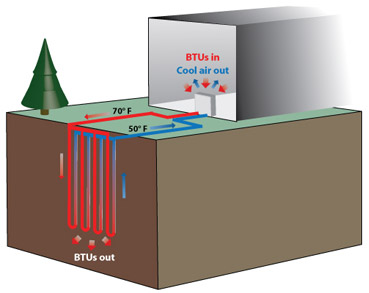Geothermal heat pump (GHP) systems, which harness moderate and constant temperatures just below the Earth’s surface, are being deployed in nearly every region of the world and in residential, commercial, institutional, and industrial environments with great success. Despite recent setbacks in deployments in many parts of the world due to the economic downturn, the future looks bright for the worldwide GHP market.
According to a recent report from Navigant Research, the worldwide installed capacity of GHP systems will grow by nearly 150 percent over the next 7 years, from 52.7 gigawatts-thermal (GWt) to 127.4 GWt.
“The renewable energy policies that led to strong growth in the GHP market in the last decade are still in place, and will drive expansion as the global economy improves,” says Mackinnon Lawrence, principal research analyst with Navigant Research. “Although their overall penetration remains low, GHP installations are gaining traction in both the construction industry and the regulatory environment, and this high-efficiency technology will likely play a larger role in both new build and retrofit projects going forward.”
In some ways, the fortunes of the GHP market are tied to that of the housing market: As the number of housing starts increases, so do the opportunities for installers and engineers of GHP systems to deploy their technology. Yet, a number of factors affect a homeowner’s or residential developer’s decision to deploy GHPs in a project, including quality of construction, construction budget, ease of getting a loan, and importance of green image. Thus, while the rate of housing starts has grown steadily over the last 2 years, the rate of GHP deployments has not kept pace, the study concludes.
The report, “Geothermal Heat Pumps,” analyzes the global market opportunity for geothermal heat pumps, including a comprehensive examination of GHP markets, demand drivers, existing and emerging technologies, the public policy and regulatory environment, and key industry players. Market forecasts, segmented by geography and market segment, extend through 2020 and include examinations of market dynamics in all key regions worldwide. An Executive Summary of the report is available for free download on the Navigant Research website.
About Navigant Research
Navigant Research, the dedicated research arm of Navigant, provides market research and benchmarking services for rapidly changing and often highly regulated industries. In the energy sector, Navigant Research focuses on in-depth analysis and reporting about global clean technology markets. The team’s research methodology combines supply-side industry analysis, end-user primary research and demand assessment, and deep examination of technology trends to provide a comprehensive view of the Smart Energy, Smart Utilities, Smart Transportation, Smart Industry, and Smart Buildings sectors. Additional information about Navigant Research can be found at www.navigantresearch.com.
About Navigant
Navigant is a specialized, global expert services firm dedicated to assisting clients in creating and protecting value in the face of critical business risks and opportunities. Through senior level engagement with clients, Navigant professionals combine technical expertise in Disputes and Investigations, Economics, Financial Advisory and Management Consulting, with business pragmatism in the highly regulated Construction, Energy, Financial Services and Healthcare industries to support clients in addressing their most critical business needs. More information about Navigant can be found at www.navigant.com.
Related Stories
| May 29, 2014
7 cost-effective ways to make U.S. infrastructure more resilient
Moving critical elements to higher ground and designing for longer lifespans are just some of the ways cities and governments can make infrastructure more resilient to natural disasters and climate change, writes Richard Cavallaro, President of Skanska USA Civil.
| May 23, 2014
Top interior design trends: Gensler, HOK, FXFOWLE, Mancini Duffy weigh in
Tech-friendly furniture, “live walls,” sit-stand desks, and circadian lighting are among the emerging trends identified by leading interior designers.
| May 20, 2014
Kinetic Architecture: New book explores innovations in active façades
The book, co-authored by Arup's Russell Fortmeyer, illustrates the various ways architects, consultants, and engineers approach energy and comfort by manipulating air, water, and light through the layers of passive and active building envelope systems.
| May 19, 2014
What can architects learn from nature’s 3.8 billion years of experience?
In a new report, HOK and Biomimicry 3.8 partnered to study how lessons from the temperate broadleaf forest biome, which houses many of the world’s largest population centers, can inform the design of the built environment.
| May 13, 2014
19 industry groups team to promote resilient planning and building materials
The industry associations, with more than 700,000 members generating almost $1 trillion in GDP, have issued a joint statement on resilience, pushing design and building solutions for disaster mitigation.
| May 11, 2014
Final call for entries: 2014 Giants 300 survey
BD+C's 2014 Giants 300 survey forms are due Wednesday, May 21. Survey results will be published in our July 2014 issue. The annual Giants 300 Report ranks the top AEC firms in commercial construction, by revenue.
| Apr 29, 2014
USGBC launches real-time green building data dashboard
The online data visualization resource highlights green building data for each state and Washington, D.C.
| Apr 22, 2014
Bright and bustling: Grimshaw reveals plans for the Istanbul Grand Airport [slideshow]
In partnership with the Nordic Office of Architecture and Haptic Architects, Grimshaw Architects has revealed its plans for the terminal of what will be one of the world's busiest airports. The terminal is expected to serve 150 million passengers per year.
| Apr 9, 2014
Steel decks: 11 tips for their proper use | BD+C
Building Teams have been using steel decks with proven success for 75 years. Building Design+Construction consulted with technical experts from the Steel Deck Institute and the deck manufacturing industry for their advice on how best to use steel decking.
| Apr 4, 2014
$25 million Orion Jet Center designed by SchenkelShultz now open
As the centerpiece of the 45-acre campus, which is its first phase of a planned 215-acre mixed-use development, the 18,000 square foot executive terminal facility offers spacious passenger areas, administrative space, an executive suite, rental car kiosk, catering and a cafe.

















